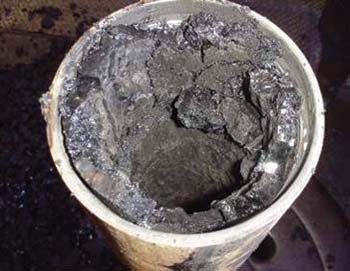
Fluorescence correlation helps resolve mystery over asphaltene
Technique helps describe the basic nature of “the cholesterol of petroleum.”
Lynn M. Savage
From the well to the refinery, the flow of crude oil is impeded by asphaltene, a heavy, aromatic substance that separates out of the crude, then aggregates readily, causing pipe blockages, coke formation, catalyst deactivation and other problems. Petrochemists would like to solve the dilemmas that result from asphaltene, but unresolved controversies surround the basic structure of the material, including debates over the size, weight and composition of its molecules.

Asphaltene, also known as “the cholesterol of petroleum,” is the heaviest and most aromatic component of crude oil. It is shown here clogging a pipe. Courtesy of A. Ballard Andrews.
Because asphaltene begins to form aggregates at concentrations as low as 0.05 g/l, A. Ballard Andrews and his colleagues at Schlumberger-Doll Research in Ridgefield, Conn., wanted to study concentrations of 0.03 to 3.0 mg/l. To nondestructively measure asphaltene at concentration levels this low, they turned to fluorescence correlation spectroscopy, tracking the translational diffusivity of the material. Knowing the speed at which it diffuses in solution enabled them to infer the size and shape of each molecule.
The researchers acquired spectroscopic measurements using a lab-built apparatus comprising a 405-nm, 20-mW laser from New Focus Inc. of San Jose, Calif., that was coupled to two avalanche photodiodes from Pacer Components plc of Reading, UK, and another device, designed and built by entrepreneur Jixiang Zhu, to cross-correlate the fluorescence intensity fluctuations. They chose the laser wavelength because the absorption spectra of asphaltene plummet at longer wavelengths and because the emission spectra have nearly no UV component.
The asphaltene itself is naturally fluorescent and, therefore, did not require fluorophore tags, but the scientists also used perylene, octaethyl-porphyrin and quantum dots to compare their diffusivity with that of asphaltene in solution with toluene at room temperature.
They found that the diffusion rate of asphaltene — about 0.35× 10–5 cm2/s — was similar to that of the octaethyl-porphyrin, suggesting that they are close in size: ~1-nm radius. Furthermore, the size of the asphaltene demonstrated that it is not a huge collection of aromatic domains that are attached to long carbon chains.
According to Andrews, the scientists are examining asphaltenes from oil-bearing regions worldwide as well as coal-bound asphaltenes in support of “petroleomics” (analogous to genomics), the prediction of all of the properties of petroleum based on a complete listing of the components in a given type of crude oil.
Journal of Physical Chemistry A, July 6, 2006, pp. 8093-8097.
Published: September 2006